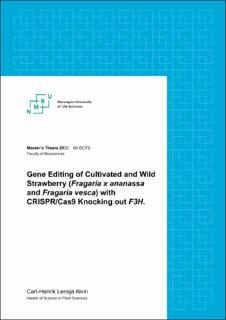| dc.description.abstract | The goal of this thesis was to transform the cultivated strawberry, Fragaria x ananassa, and the wild strawberry, Fragaria vesca, using Clustered Regularly Interspaced Short Palindromic Repeats (CRISPR) alongside CRISPR associated protein 9 (Cas9). The CRISPR/Cas9 system would be used to induce a knock-out mutation in the F3H gene of both the cultivated and wild strawberry. The F3H gene is an important gene in the anthocyanin pathway and, if knocked-out, it is postulated that the production of anthocyanins would cease. This could result in strawberries that are unable to produce color pigments, yielding white berries or berries with different shades of pigmentation. This would serve as a proof-of-concept for CRISPR/Cas9 in these strawberries.
The strawberry is an important horticultural crop in Norway. However, environmental challenges and disease control are challenging aspects of the production of this crop. Due to reduced availability of legal fungicides, the challenges increase each time a fungicide is taken off the list of approved pesticides in Norway. Climate changes, such as more rain and wet weather during the maturation phase of strawberries, add to the possibility of fungal diseases and hence, yield losses. To face these challenges, the development of new cultivars is important. The CRISPR/Cas9 system allows the precise introduction of mutations in the plant genome, as well as the deletion and insertion of larger fragments of DNA. These attributes allow for a more precise and stable deletion, or introduction, of traits to a cultivar than traditional breeding techniques, which is a long and winding road toward success. The CRISPR/Cas9 system could, therefore, be an important tool when breeding new cultivars. This could also be another tool to introduce novel genes for resistance from wild strawberries through cis-genesis of wild characters into the gene pool of cultivated strawberries.
The octoploid nature of the cultivated strawberry makes it an interesting test of the capabilities of the CRISPR/Cas9 system. When this thesis was planned, few attempts at CRISPR/Cas9 mediated mutation of the strawberry had been done. The goal of this thesis was, therefore, to develop a protocol for the CRISPR/Cas9 mediated transformation of the cultivated and wild strawberry. The goal of this thesis was not achieved, due to technical challenges coupled with the closure of available laboratory facilities because of the Covid19 pandemic. However, an extensive troubleshooting process of the seamless assembly method presented by Li et al. (2015) explains potential challenges of plasmid construction. Also, successful attempts at direct regeneration of strawberry explants show that it is possible to circumvent the use of callus when using CRISPR/Cas9, thus possibly avoiding the increased risk of somaclonal variation from the use of callus. | en_US |

